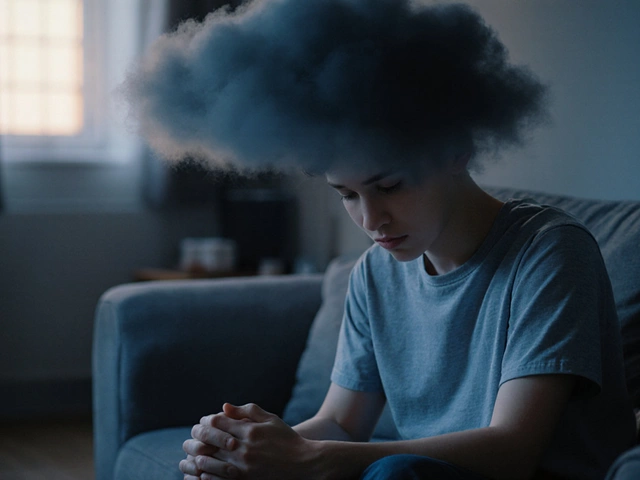Ever felt like therapy might be a good idea but never actually went for it? You're definitely not alone. Millions of people need mental health support but never get around to seeking therapy. It's a bit like knowing exercise is good for you but not hitting the gym. The reasons are plenty and often revolve around costs, stigma, or simply not knowing where to start.
Unfortunately, ignoring mental health needs doesn't make them disappear. Quite the contrary, really. Unaddressed mental issues can impact everything from your work to your relationships. Imagine carrying an invisible weight around all day. It just slows you down.
So, what's holding everyone back from getting the help they need? The struggle is real: long waiting lists, lack of information, and societal pressures stop people in their tracks. Plus, the myths and misconceptions floating around don’t help either.
Let's dig a little deeper into why this happens and what we can do to change it. Addressing these barriers is crucial if we want to support everyone’s mental well-being and help people live better lives.
- The Growing Need for Mental Health Therapy
- Barriers to Accessing Therapy
- Consequences of Untreated Mental Issues
- Public Perceptions and Stigma
- How to Encourage and Improve Access
The Growing Need for Mental Health Therapy
These days, it's not hard to spot the signs of a booming *mental health* crisis. It seems like everyone, from teenagers stressed about exams to adults juggling work and family, could use a little therapy. But why is this need growing so rapidly?
One big reason is the fast-paced world we're living in. With the constant barrage of social media, demanding jobs, and global issues filling our screens, it's easy for anxiety to take hold. Studies have shown a sharp rise in anxiety and depression, especially among young people. The pandemic only made things worse, piling on isolation and uncertainty.
You might think therapy would naturally expand to meet this demand, but that's not quite happening. Many people don't seek treatment due to high costs or the fear of being judged. It's like needing a plumber for a leaky faucet but not calling one because it's too expensive or because you think you should be able to fix it yourself.
Here’s a look at some eye-opening stats: According to recent surveys, over 76% of individuals believe they need therapy but never actually pursue it. Why? Barriers like access, affordability, and the stigma surrounding mental health care get in the way.
| Age Group | % Needing Therapy |
|---|---|
| Teens (13-19) | 40% |
| Adults (20-39) | 58% |
| Middle-aged (40-59) | 25% |
| Seniors (60+) | 12% |
So, how do we tackle this overwhelming demand for mental health therapy? We need more awareness, more acceptance, and more accessible options. Innovators are starting to break ground with online therapy and community support systems, offering more flexible and affordable options.
By acknowledging the reality that so many people need help, we're taking the first step towards bridging this gap. Supporting mental health initiatives and breaking down these barriers isn’t just good sense; it's essential for healthier communities and happier individuals.
Barriers to Accessing Therapy
Alright, let’s talk about these roadblocks people face when trying to get mental health care. Believe it or not, one of the biggest ones is simply the cost. Yep, therapy can be pricey. Not everyone has insurance that covers it, and for some, even a sliding scale fee is too much. If you compare it to seeing a regular doctor, therapy bills can seem a bit overwhelming.
Another massive hurdle is stigma. Even today, many people are still hesitant to admit they need help. In some circles, needing therapy is wrongly seen as a sign of weakness. This outdated view stops lots of folks from reaching out for the support they really need.
Then there’s the issue of accessibility. In many places, there's a shortage of mental health professionals. This is especially true in rural areas where you might have a hard time even finding a trained therapist nearby. It's like looking for water in a desert!
And let’s not forget about the time factor. Finding the time to see a therapist regularly can be tough. Juggling between work, family, and other responsibilities leaves many to think, “When do I fit therapy into all this?”
Interestingly, a study highlighted that only about 40% of people with mental disorders in high-income countries get any form of treatment, let alone therapy. That’s a pretty low turnout!
Here’s a quick breakdown of some typical barriers:
- High Costs: With or without insurance, therapy can strain the budget.
- Stigma: The fear of being judged or misunderstood keeps many away.
- Lack of Providers: Especially in less populated areas, it can be a real hunt.
- Time Constraints: Everyone’s so busy these days, right?
Understanding these barriers is the first step in overcoming them. When we talk about it openly, we begin to shift the conversation and can start finding creative ways to make therapy more accessible for everyone.

Consequences of Untreated Mental Issues
Leaving mental health problems unaddressed is like ignoring a leaky roof—it only gets worse over time. For those who don't access the mental health care they need, the consequences can be profound. Think about daily life struggles that pile up without proper therapy, like stress, anxiety, or depression turning into chronic conditions.
When mental health issues go untreated, they often spiral into more severe problems. Research shows that untreated depression can increase the risk of substance abuse, and anxiety can lead to heart problems. It's like missing the root cause of a headache by only popping painkillers.
Moreover, ignoring your mental well-being doesn't just affect you. It spills over into your relationships, work, and overall life satisfaction. Many people find their performance at work declines, leading to a cycle of stress and even job loss. Imagine trying to concentrate at work while battling the weight of untreated mental struggles—nearly impossible, right?
In fact, untreated mental disorders can also increase the incidence of physical health issues. There’s a genuine connection between mental and physical health. How you feel mentally often mirrors your physical state, so if you’re not feeling your best mentally, your body might suffer too.
Consider this, studies suggest that untreated mental illness alone costs millions in lost productivity globally each year. It's not just a personal issue; it's a public health challenge too.
So, what's the takeaway? Addressing mental health needs is essential. The first step might simply be acknowledging that help is needed. From there, seeking accessible options (like online therapy) could make a world of difference. Facing these issues head-on could prevent a small problem today from becoming a much bigger issue tomorrow.
Public Perceptions and Stigma
One of the biggest roadblocks to seeking mental health support is the stigma that still clings to it. You'd think with all the progress society has made, talking about mental health care would be as normal as chatting about a sprained ankle, right? But sadly, misconceptions and judgments are still alive and kicking.
For a lot of people, admitting the need for therapy feels like waving a red flag saying they're 'broken' or 'weak'. It's weird because the same doesn't apply if you need a doctor for a physical ailment. This double standard keeps folks from reaching out and getting help they might desperately need.
Surveys reveal that around 60% of people struggling with mental health issues never seek help due to the fear of being labeled or judged. It’s a huge figure when you think about all the individuals silently fighting their battles. Tackling this stigma is crucial as it prevents many from even taking the first step.
How do we tackle this? Well, it starts with open conversations. The more we talk and share real-life stories, the more we can change these perceptions.
- Education: Programs in schools and workplaces can spread awareness that therapy is not just okay, but often necessary.
- Shared Experiences: Encouraging public figures or just anyone who's been through therapy to talk about their experiences can break down these barriers.
- Changing Language: Words matter. We should be careful not to use mental health terms as slurs or jokes.
The goal is to make therapy as natural as any other part of health care, letting everyone feel comfortable to seek the help they need without second-guessing themselves.

How to Encourage and Improve Access
So, you've realized that more people need to get the mental health support they deserve. But how can we make it happen? Accessing mental health services should be as easy as grabbing a cup of coffee, but unfortunately, we're not there yet. Let's break it down and see what could help bridge this gap.
The first step is to make therapy more affordable. High costs can deter many from seeking help. Governments and organizations can step in by providing subsidies or insurance plans that cover therapy sessions. It's not just a cost; it's an investment in the nation's well-being.
Another barrier is the sheer lack of information. Many people simply don't know how to find a good therapist or what treatment is right for them. We can address this by enhancing public education about available mental health resources. Hospitals and clinics could host workshops or offer online resources to guide people.
Technology is our friend. Teletherapy has exploded in the past few years, especially since the pandemic. It’s definitely worth promoting as an accessible option. Not everyone can physically attend sessions, so virtual options open doors for many.
To make therapy mainstream, we must tackle stigma head-on. Encouraging open discussions about mental health on social media and in public forums can demystify the process. When people like you and me share our stories, it chips away at the barriers built by old misconceptions.
Finally, why not involve communities? Local support groups can provide a platform for people to express their struggles without judgment. Schools and workplaces could integrate mental wellness programs, providing easy access to help right where you spend most of your day.
Increasing access to mental health care isn't a magic trick. It takes effort and awareness, but each step we take can make a massive difference. By removing the obstacles, we offer everyone a chance to thrive mentally and lead fuller lives.







